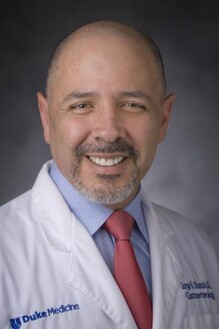 From the DukeHealth.org archives. Content may be out of date.
From the DukeHealth.org archives. Content may be out of date.
Enjoying Life after Whipple Procedure for Pancreatic Cancer

Whipple procedure at Duke cured Kathleen O'Day of pancreatic cancer
No one in Kathleen O’Day’s New York hometown could figure out why she was experiencing stomach and back pain, vomiting and jaundice. At her son-in-law’s urging, the retired teacher came to Duke where she was diagnosed with pancreatic cancer. A complex procedure called Whipple cured her. “I’m doing great,” she said recently from her new home in Raleigh.
Wrong Diagnosis in New York Leads to Medical Care in Raleigh
Kathleen O’Day had just retired from teaching in 2012 when she started feeling sick. Having her gall bladder removed didn’t help. “I was throwing up all the time. I had terrible stomach and back pain.” When she could take it no longer, she went to the emergency room at a hospital near her home in Glen Falls, NY. “They put a stent in my bile duct.”
That only made things worse, and prompted O’Day’s son-in-law, a doctor in Raleigh, to say enough was enough. It was time to go to Duke.
Pancreatic Cancer was the Cause; Whipple was Her Only Chance for a Cure
Dr. Jorge Obando, MD, a gastroenterologist at Duke Raleigh Hospital, performed an upper endoscopy, during which a small camera is inserted into the mouth to reach the pancreas and view the placement of the stent. Obando could see the New York doctors had used the wrong size stent to clear a blockage in her bile duct, but that was only one cause of her persistent pain. O’Day had pancreatic cancer.
“It was a blessing in disguise,” said O’Day about her New York experience. “If they had put the right size stent in, I could have gone on for years. I would have ended up with much more advanced pancreatic cancer.”
Obando referred O’Day to Dr. Alexander Perez, MD, a pancreatic surgeon at Duke Cancer Center at the time. Dr. Perez recommended she undergo a complex procedure called Whipple.
“It was her only chance for a cure,” said Dr. Perez.
Laparoscopic Whipple Maximizes Benefits
A diagnosis of pancreatic cancer can be devastating because it is often discovered after it has spread beyond the pancreas to other blood vessels, lymph nodes or organs. At that point, treatment options are limited. Only about 20 to 30% of patients, like O’Day, are diagnosed when the cancer can be successfully removed, explained Perez.
The Whipple procedure, or pancreatoduodenectomy, is the only possible chance for a cure. The aggressive, difficult procedure is recommended when the pancreatic cancer is confined to the head of the pancreas. To remove the tumor, the surgical team must remove parts of the pancreas, the small intestine and gallbladder, then reconstruct the remaining portions so they can function.
“Because of its dramatic impact on patients’ lives, we do our best to minimize the side effects of the surgical intervention and maximize the benefits,” Dr. Perez said. “That is why performing this procedure using minimally invasive techniques is so important.”
Duke Expertise in Laparoscopic Whipple has Proven Results
Laparoscopic Whipple uses small incisions in the abdominal wall, rather than one large one. Surgeons rely on advanced imaging capabilities in the operating room, and tiny, specially designed instruments to navigate to, and manipulate the vital organs.
Duke is one of the few places in the country with the expertise to offer laparoscopic Whipple. “We have more experience than most centers, and we have published our results to demonstrate that performing laparoscopic Whipple reduces the length of hospital stay, blood loss, the risk of infection, and wound complications,” Dr. Perez said.
Asking Questions Confirms Confidence in her Doctor
O’Day knew the stakes were high when Dr. Perez recommended the surgery and gave his recommendation considerable thought. “I had a lot of questions for him. I wanted to know if Duke did a lot of these surgeries. I knew they had to perform a certain number in order for the procedure to be safe. I wanted to know their track record and Dr. Perez’s qualifications. Dr. Perez was extremely confident in his ability. He reassured me. He had an experienced team. I remember him saying that this is the Mt. Everest of surgeries and he was going to take me to the top. His confidence is well deserved.”
O’Day sailed through the surgery and was out of the hospital within one week. “It was fantastic. I had no complications,” she said. Shortly after the operation, she underwent chemotherapy and radiation. She worked closely with doctors and social workers who helped her adjust to life after her diagnosis and returns to the Duke Cancer Center for scans on a regular basis. “All my scans are good.”
Today, three years later, 68-year-old O’Day is living with her daughter and son in law’s family in Raleigh and doing great. “I babysit. I exercise. I belong to a gym. I have a wonderful quality of life.”




